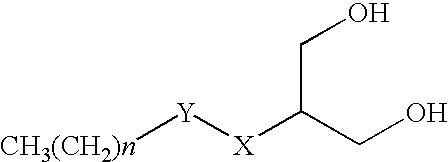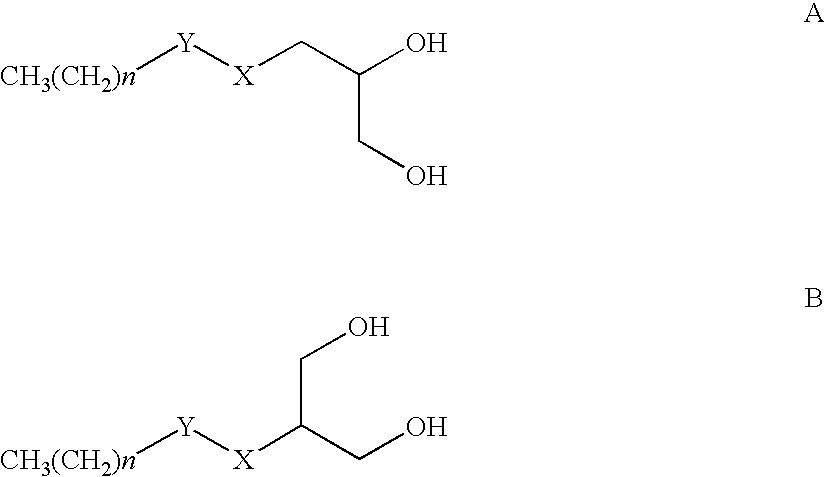Thickened oil compositions of edible oil
a technology of edible oil and composition, which is applied in the directions of aerosol delivery, plant/algae/fungi/lichens ingredients, fruits/vegetable preservation by heating, etc. it can solve the problems of reducing the blood level of hdl cholesterol with trans-fatty acids, consuming a lot of effort to produce solidified unsaturated oils, and reducing the amount of saturated fat in the oil
- Summary
- Abstract
- Description
- Claims
- Application Information
AI Technical Summary
Benefits of technology
Problems solved by technology
Method used
Image
Examples
example 1
Production of Beeswax-Derived Fatty Alcohols
[0183] Twenty grams of beeswax were added to 50 grams of ethanol at 60.degree. C with stirring. A large amount of foam was generated during this process. When the beeswax was completely dissolved in the ethanol, the mixture was allowed to cool off. Upon cooling, a white solid layer was formed at the bottom of the flask. The alcohol layer was decanted and the remaining solid was washed with water, to yield 9 grams of product. Gas chromatography-mass spectroscopy (GCMS) analysis revealed that the product comprised a mixture of long chain alcohols, having a general formula of C.sub.nH.sub.2n+1-OH, in the following composition (Table 2):
2 TABLE 2 n Relative intensity 23 3.0 25 4.1 27 3.0 29 0.8 31 2.0 33 4.9
example 2
Thickened Edible Olive Oil-Flavor System
[0184] Eight grams of behenic acid were added to 90 grams of olive oil and the mixture was stirred at 60.degree. C. until the acid was completely dissolved in 5 the oil. 0.3 gram of garlic extract, 0.5 gram salt and 0.2 gram ground majoran were added to the hot mixture and the mixture was cooled to 30.degree. C. with stirring, then poured into containers and cooled to room temperature. A gelatin-like system was obtained, with taste and smell similar to the original olive oil. Upon shaking at 30.degree. C., the gel became liquid and after application on food surface it became solid again.
example 3
Thixotropic Edible Olive Oil-Flavor System
[0185] The method of Example 2 was applied, using 8 grams of stearyl is alcohol instead of behenic acid. Results were similar.
PUM
| Property | Measurement | Unit |
|---|---|---|
| molecular weight | aaaaa | aaaaa |
| specific gravity | aaaaa | aaaaa |
| specific gravity | aaaaa | aaaaa |
Abstract
Description
Claims
Application Information
 Login to View More
Login to View More - R&D
- Intellectual Property
- Life Sciences
- Materials
- Tech Scout
- Unparalleled Data Quality
- Higher Quality Content
- 60% Fewer Hallucinations
Browse by: Latest US Patents, China's latest patents, Technical Efficacy Thesaurus, Application Domain, Technology Topic, Popular Technical Reports.
© 2025 PatSnap. All rights reserved.Legal|Privacy policy|Modern Slavery Act Transparency Statement|Sitemap|About US| Contact US: help@patsnap.com



